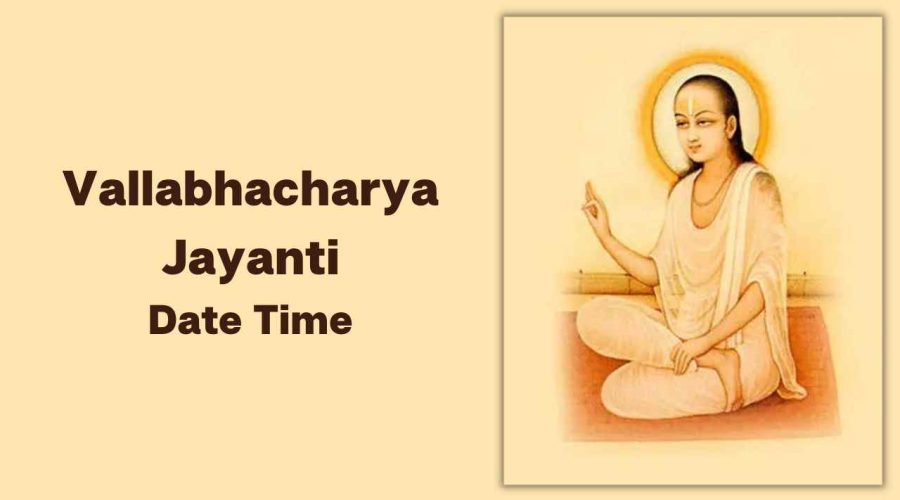Vallabhacharya Jayanti 2023 Date, Celebrations, History & Significance
Vallabhacharya, one of the most well-known Vaishnava Saints, is the founder of the Pushtimarg or Pushti Sect. April 16 is the date of Vallabhacharya Jayanti in 2023. The jayanti is observed on Vaishakh Krishna Paksha Ekadashi Tithi.
Vallabhacharya taught monism or the Shuddhadvaita School of philosophy, which emphasizes that Shri Krishna is accountable for all living and nonliving things and that a person may only obtain Moksha with His blessings. Saint Vallabha originated the practice of worshipping Lord Krishna as Shrinathji.
Vallabhacharya Jayanti Date 2023
Sunday, April 16, 2023
History of Vallabhacharya Jayanti
Around 1479, Shri Vallabhacharya Ji was born in Kashi to a Telugu Brahmin family. According to the North Indian lunar calendar Purnimant, he was born on Krishna Paksha Ekadashi during the Vaishakha month. His birthday is the same day as Varuthini Ekadashi.
The birthday of Shri Vallabhacharya, popularly known as the founder of the Pushti sect in India, is celebrated on June 14 as Vallabhacharya Jayanti. Shripad Vallabhacharya is recognised as one of the world’s greatest philosophers due to his role as the creator of the Bhakti movement in India. He was born into a Telugu Brahmin family around 1479. Vallabha shown an early interest in spiritual and intellectual matters.
In 1493, the first of his students arrived in Mathura, the centre of his activities. He travelled extensively throughout India, promoting the bhakti philosophy and Lord Krishna devotion. At the base of Mount Govardhana, near to Mathura, he discovered the Shri-Nathaji image, the cult’s primary object of devotion. The event is observed in Gujarat, Maharashtra, Chennai, Uttar Pradesh, and Tamil Nadu.
When Vallabha’s mother gave birth, most of northern and central India had been conquered by Muslim invaders, therefore the region was affected by the battle. Communities regularly relocate to avoid religious conversion and persecution. Shri Lakshmana Bhatta and his pregnant wife had to leave Varanasi on one of these instances. Due to the stress and physical exertion of the flight, Vallabha’s parents hid him behind a tree and covered him with a blanket so that others would believe he was dead.
Mythology states that Shri Krishna appeared in the dreams of Vallabhacharya’s parents to inform them that their son was a young version of Lord Krishna. When parents realised the predicament, they hurriedly checked to see if their child was still alive. The infant was discovered when the mother of Vallabha extended her hand into the scorching flames. The parents then gave their child the name Vallabha.
Significance of Vallabhacharya Jayanti
According to legend, during one of his journeys to the northwestern region of India, Vallabhacharya observed an unusual phenomena near Mount Govardhan. There, he witnessed a cow daily travelling to a specific area on the mountain and releasing milk. Vallabhacharya requested that the area be excavated, and there they discovered the idol of Shree Nathji.
It is believed that Lord Krishna appeared in the shape of Shree Nathji and hugged Vallabhacharya.
Some regard Vallabhacharya to be an incarnation of the fire god Lord Agni. Vallabha emphasised Pushti (grace) and Bhakti (devotion) heavily (devotion). The devotees of Vallabhacharya venerate Bala Krishna, the youthful Krishna.
Vallabhacharya’s significant literary works based on Pushtimarg include Vyasa Sutra Bhashya, Jaimini Sutra Bhasya, Bhagavata Tika Subodhini, Pushti Pravala Maryada, and Siddhanta Rahasya. Vallabhacharya authored works in both Sanskrit and Brij.
Vallabhacharya is supposed to have meditated in Ramghat in Haridwar, which is a significant location for his disciples.

